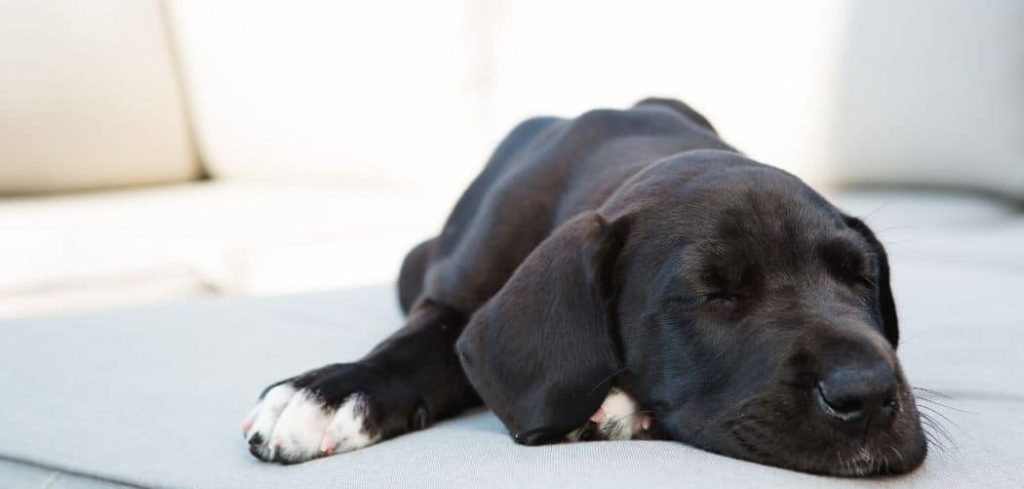It’s unsettling to see your dog panting heavily and shaking after surgery. These behaviors can leave dog owners feeling anxious, especially when they’re unsure whether it’s a normal part of recovery or something more serious.
We outline the common causes of a dog panting and shaking after surgery, what you can do at home, and when to seek veterinary help.
Table of Contents
Dog Panting and Shaking After Surgery — Why It Happens
Dog panting and shaking after surgery can be caused by pain, anesthesia aftereffects, stress, low blood sugar, or complications like infection.
Post-operative panting and trembling are relatively common, but they can also indicate your dog is in distress. Medications, disorientation, or pain from the procedure may trigger these symptoms.
In some cases, these signs are part of a normal healing response, while in others they signal something more urgent.

Common Causes of Panting and Shaking After Surgery in Dogs
Anesthesia Recovery
Many dogs pant and tremble while recovering from anesthesia.
As the drugs wear off, your dog may feel disoriented, cold, or dizzy. Shaking and heavy breathing are common side effects of sedatives and anesthetic agents.
These symptoms often resolve within 12–24 hours but should gradually improve — not worsen — over time.
If the shaking becomes more intense or is accompanied by other signs like vomiting or pale gums, it may point to a reaction or complication that needs veterinary attention.
Related: Dog panting excessively (Causes and What To Do)
Pain or Discomfort
Surgical pain is one of the most frequent causes of post-op panting and shaking.
Even with pain medication, some dogs experience discomfort during healing. Panting is a dog’s way of expressing stress or pain, and trembling may be a sign they’re trying to cope with that sensation.
This is especially true after invasive procedures like abdominal or orthopedic surgery.
It’s important to follow your vet’s pain management plan closely and notify them if your dog seems distressed or restless.
Hypothermia
Some dogs develop mild hypothermia after surgery.
Anesthesia can lower a dog’s body temperature, and shaking is a reflexive response to being cold.
Smaller dogs, older pets, or those with low body fat are more susceptible. Hypothermia can persist even after the dog appears awake and alert.
Panting may also occur if the dog is trying to regulate its body temperature or feeling anxious about the chills.
Hypoglycemia
Low blood sugar can lead to trembling and rapid breathing.
If your dog hasn’t eaten post-surgery — especially after a long fast — their glucose levels may dip.
Small breeds, puppies, and dogs with diabetes are more vulnerable. In these cases, panting and shaking may come with weakness, lethargy, or confusion.
Providing a small, bland meal (if your vet permits) can help stabilize energy levels and reduce symptoms.
Infection or Surgical Complication
In some cases, panting and shaking may signal an infection or other complication at the surgical site.
Signs to watch for include a swollen or oozing incision, fever, foul odor, or decreased appetite. These symptoms typically appear 1–3 days post-surgery but can develop sooner.
Shaking and panting may be your dog’s way of responding to the systemic effects of infection or inflammation.
Prompt veterinary care is essential to catch and treat issues early.
Anxiety and Stress
Being in pain, wearing a cone, or feeling disoriented can all trigger stress-related panting and trembling.
Dogs may feel overwhelmed in their post-op environment, especially if they’re confined, alone, or unable to move normally. Anxiety can amplify physical symptoms even in the absence of complications.
Comforting your dog, providing a calm environment, and speaking gently can help ease their distress.
What to Do If Your Dog Is Panting and Shaking After Surgery
Keep your dog in a quiet, temperature-controlled room and monitor them closely.
Make sure they are warm, especially if they’re small or short-haired. Use blankets or a heating pad (set on low and wrapped in a towel) if needed. Offer small sips of water and, if cleared by your vet, a bland meal to restore energy.
Stick to the prescribed pain medication schedule, even if your dog “seems okay.” If your dog appears restless, whines, or doesn’t settle, they may be experiencing breakthrough pain.
Avoid sudden movements, loud noises, or handling your dog too much — overstimulation can worsen trembling and stress.
If you’re unsure whether what you’re seeing is normal, take a short video to show your vet.
When to Call or Visit Your Vet
Call your vet if your dog’s panting and shaking persist beyond 24 hours or get worse instead of better.
Seek help immediately if you notice:
Swelling, discharge, or bleeding at the surgical site
Refusal to eat or drink for more than 24 hours
Vomiting, diarrhea, or lethargy
Pale gums or signs of collapse
Uncontrollable shaking or seizures
These could indicate infection, internal bleeding, a drug reaction, or another serious post-op complication.
Always trust your instincts — if your dog doesn’t seem right, it’s better to call.
Read more: Dog Panting and Abdominal Pain (What it means)
Key Takeaway
Panting and shaking after surgery can be a normal part of your dog’s recovery, but it’s also something to monitor closely.
Causes range from pain and stress to more serious complications like infection or hypoglycemia. Your vet is your best partner in determining what’s expected and what’s not.
With proper rest, warmth, and pain control, most dogs feel better within a day or two. But don’t hesitate to reach out if anything feels off — your vigilance can make all the difference in your dog’s healing journey.
